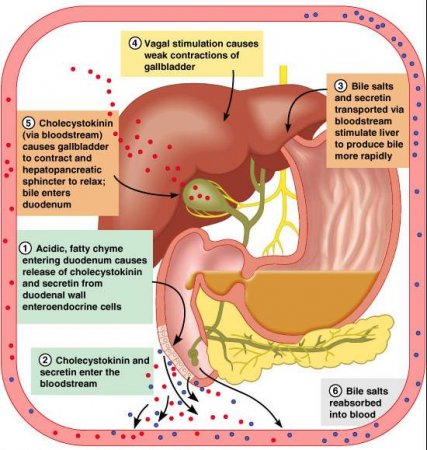Physiology of the pancreas
- Category: Digestive system, Endocrine system
- Views: 9333
Digestion
The exocrine portion of the pancreas plays a major role in the digestion of food. The stomach slowly releases partially digested food into the duodenum as a thick, acidic liquid called chyme. The acini of the pancreas secrete pancreatic juice to complete the digestion of chyme in the duodenum. Pancreatic juice is a mixture of water, salts, bicarbonate, and many different digestive enzymes. The bicarbonate ions present in pancreatic juice neutralize the acid in chyme to protect the intestinal wall and to create the proper environment for the functioning of pancreatic enzymes. The pancreatic enzymes each specialize in digesting specific compounds found in chyme.
- Pancreatic amylase breaks large polysaccharides like starches and glycogen into smaller sugars such as maltose, maltotriose, and glucose. Maltase secreted by the small intestine then breaks maltose into the monosaccharide glucose, which the intestines can directly absorb.
- Trypsin, chymotrypsin, and carboxypeptidase are protein-digesting enzymes that break proteins down into their amino acid subunits. These amino acids can then be absorbed by the intestines.
- Pancreatic lipase is a lipid-digesting enzyme that breaks large triglyceride molecules into fatty acids and monoglycerides. Bile released by the gallbladder emulsifies fats to increase the surface area of triglycerides that pancreatic lipase can react with. The fatty acids and monoglycerides produced by pancreatic lipase can be absorbed by the intestines.
- Ribonuclease and deoxyribonuclease are nucleases, or enzymes that digest nucleic acids. Ribonuclease breaks down molecules of RNA into the sugar ribose and the nitrogenous bases adenine, cytosine, guanine and uracil. Deoxyribonuclease digests DNA molecules into the sugar deoxyribose and the nitrogenous bases adenine, cytosine, guanine, and thymine.
Blood Glucose Homeostasis
The endocrine portion of the pancreas controls the homeostasis of glucose in the bloodstream. Blood glucose levels must be maintained within certain limits so that there is a constant supply of glucose to feed the cells of the body but not so much that glucose can damage the kidneys and other organs. The pancreas produces 2 antagonistic hormones to control blood sugar: glucagon and insulin.
- The alpha cells of the pancreas produce glucagon. Glucagon raises blood glucose levels by stimulating the liver to metabolize glycogen into glucose molecules and to release glucose into the blood. Glucagon also stimulates adipose tissue to metabolize triglycerides into glucose and to release glucose into the blood.
- Insulin is produced by the beta cells of the pancreas. This hormone lowers blood glucose levels after a meal by stimulating the absorption of glucose by liver, muscle, and adipose tissues. Insulin triggers the formation of glycogen in the muscles and liver and triglycerides in adipose to store the absorbed glucose.
Regulation of Pancreatic Function
The pancreas is controlled by both the autonomic nervous system (ANS) and the endocrine system. The ANS has 2 divisions: the sympathetic and the parasympathetic.
- Nerves of the sympathetic division become active during stressful situations, emergencies, and exercise. Sympathetic neurons stimulate the alpha cells of the pancreas to release the hormone glucagon into the bloodstream. Glucagon stimulates the liver to begin the breakdown of the energy storage molecule glycogen into smaller glucose molecules. Glucose is then released into the bloodstream for the organs, especially the heart and skeletal muscles, to use as energy. The sympathetic nerves also inhibit the function of beta cells and acini to reduce or prevent the secretion of insulin and pancreatic juice. The inhibition of these functions provides more energy for other parts of the body that are active in dealing with the stressful situation.
- Nerves of the parasympathetic division of the ANS become active during restful times and during the digestion of a meal. Parasympathetic nerves stimulate the release of insulin and pancreatic juice by the pancreas. Pancreatic juice helps with the digestion of food while insulin stores the glucose released from the digested food in the body’s cells.
The endocrine system uses 2 hormones to regulate the digestive function of the pancreas: secretin and cholecystokinin (CCK).
- Cells in the lining of the duodenum produce secretin in response to acidic chyme emerging from the stomach. Secretin stimulates the pancreas to produce and secrete pancreatic juice containing a high concentration of bicarbonate ions. Bicarbonate reacts with and neutralizes hydrochloric acid present in chyme to return the chyme to a neutral pH of around 7.
- CCK is a hormone produced by cells in the lining of the duodenum in response to the presence of proteins and fats in chyme. CCK travels through the bloodstream and binds to receptor cells in the acini of the pancreas. CCK stimulates these cells to produce and secrete pancreatic juice that has a high concentration of digestive enzymes. The high levels of enzymes in pancreatic juice help to digest large protein and lipid molecules that are more difficult to break down.
Pancreatic health problems
If the ducts leading from the pancreas are blocked in some way – such as when a gallstone blocks the ampulla of Vater - pancreatic fluids can build up in the pancreas and may then become activated so that they digest the pancreas itself. This condition is known as acute pancreatitis. If the onset is gradual and longer-term, we call it chronic pancreatitis.
Pancreatic cancer has one of the direst prognoses of any of the types of cancer, in part because it tends to be very metastatic (it spreads rapidly) and because it is often undiagnosed at an early stage.
Pancreatic surgery can be quite problematic for several reasons:
- The pancreas’ soft, spongy, tissue is very blood-rich, but its texture makes it extremely difficult to suture.
- Tumors are often advanced by the time they are detected.
Due to the complexities, candidates for surgery are often strongly advised to seek their treatment in a facility that conducts a higher volume of such procedures.
